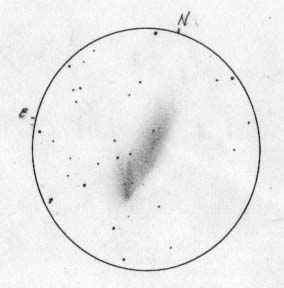 Even a streetlight that meets Flagstaff's lighting code can be a royal pain when it stands ten meters from your telescope. However, I wanted to setup the 10-inch in a place that was convenient to home and neighbors. My driveway met both criteria. The comet had moved into Ursa Major earlier in the day. I found it about 3 degrees northeast of 3.4 magnitude Muscida, the star marking the snout of the Great Bear. I spent the next 45 minutes making a sketch and sharing the view with a handful of folks who stopped by to ask what I was looking at.
Even a streetlight that meets Flagstaff's lighting code can be a royal pain when it stands ten meters from your telescope. However, I wanted to setup the 10-inch in a place that was convenient to home and neighbors. My driveway met both criteria. The comet had moved into Ursa Major earlier in the day. I found it about 3 degrees northeast of 3.4 magnitude Muscida, the star marking the snout of the Great Bear. I spent the next 45 minutes making a sketch and sharing the view with a handful of folks who stopped by to ask what I was looking at.
The drawing at left represents the view at 63X (18-mm Meade SWA eyepiece) in my 10-inch Starfinder equatorial. A bright nuclear region is immediately visible. It appears stellar at first but is seen to be slightly elongated along an north-south axis. A teardrop shaped dust tail extends to the north over some 10 arc minutes. A fainter tail extends along a north-northeast line for an equal length. A delicate plasma tail can be traced to the north-northwest for about 25 arc minutes. This tail is fairly broad, 8 arc minutes at its widest, but extremely subtle. |
![]()
![]()
